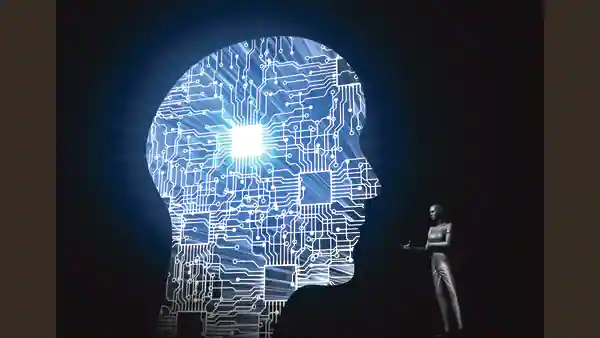- Ai is becoming more prevalent in the healthcare sector.
- India’s economy is expected to reach $1 trillion by 2035.
- AI spending in India increased by more than 109% in 2018, totaling $665 million.
Artificial intelligence (AI) is becoming more prevalent in the workplace and is now being used in healthcare applications. The increase in healthcare data implies greater use of Artificial Intelligence (AI). Early disease diagnosis, drug design, drug trials, diabetic retinopathy, cancer treatments, cardiovascular disease, and eye care are some of the key areas where Artificial Intelligence is being used.
By 2025, India’s AI expenditure is expected to reach $11.78 billion. It is anticipated to increase India’s economy by $1 trillion by 2035. There are various reasons for the massive increase in investment, particularly in AI. In India, there are only 64 doctors for every 100,000 people, compared to the global average of 150 doctors for every 100,000 people. Infrastructure is lacking in rural primary healthcare centers. This translates to a scarcity of high-quality diagnostic services in rural India, where more than 70% of the population lives. Even in cities, the impact of technology has been limited. Online doctor consultations increased significantly during COVID-19, but the impact has not been as transformative as expected.
AI integration in healthcare is not a pipe dream. It is necessary for the government to implement AI courses and AI-based curricula in schools and colleges, particularly in medical and health science colleges. Predictive analysis using Artificial Intelligence (AI) for early detection or diagnosis can be a valuable asset in the healthcare industry, particularly in rural India, where basic infrastructure and even healthcare professionals are scarce. AI-based technologies can help bridge the supply-demand gap in India’s healthcare industry, which is expected to grow to $372 billion this year.
The Role of Artificial Intelligence (AI) in Healthcare
AI spending in India increased by more than 109% in 2018, totaling $665 million. It is expected to reach $11.78 billion by 2025, boosting India’s economy by $1 trillion by 2035.
AI is already being used in diagnosis and early detection techniques. NITI Aayog, the Indian government’s public think tank, policy framework, and programme framework, has been testing the application and implementation of AI in the early detection of diabetes and is currently working on the use of AI as a screening tool in eye care. The goal is to combine AI-based technologies with portable screening devices to speed up eye screening and early diagnosis, particularly in rural and remote areas.
Artificial intelligence-based technologies are being tested in cancer research. To detect biomarkers, AI-based tools can use high-quality de-identified images. The Comprehensive Archive of Imaging was recently launched by Tata Medical Center and the Indian Institute of Technology as India’s first de-identified cancer image bank.
AI can identify risk factors for cardiovascular disease by analysing public health data. Using clinical and lab data from over 400,000 patients, Microsoft’s AI Network for Healthcare and Apollo Hospitals are developing a machine learning model to predict the potential risk of heart attacks. Without the need for a comprehensive health examination, the AI solution can identify new risk factors and provide patients with a heart risk score.
AI-based predictive analysis is also used in the drug design process. AI has the potential to accelerate the hit-to-lead stage of early drug discovery while also providing accurate drug target results.
Challenges while Integrating AI into Healthcare
Public health data, which is also one of the potential risk factors, is the primary requirement for integrating AI in healthcare. Massive amounts of patient data are required for AI-based tools and technologies. Inaccurate decisions, such as inappropriate drug prescriptions or disease detection, can be exacerbated by fragmented or inaccurate data. As a result, patients must understand how their data is being used to train AI models and provide accurate data.
The healthcare industry should also recognise that integrating AI in healthcare is only the beginning. A high level of AI-based automation may jeopardise physicians’ ability to detect errors accurately at any stage of AI integration, leading to an overreliance on AI-based tools.
AI should support healthcare decision-making, not be used to automate decision-making. AI-based tools should never be replaced with primary healthcare, but should instead help in providing advanced tools and infrastructure to rural populations.
Conclusion
AI integration in healthcare necessitates significant investments in human capital, infrastructure, regulatory frameworks, stakeholders, and business models.
AI must also be integrated into the school curriculum for medical and paramedical students. The Indian government will also need to invest appropriately in basic healthcare infrastructure. To facilitate the research being done to integrate AI-based solutions into healthcare, the government must also invest in public and private organisations such as NITI Aayog, Tata Institute of Healthcare, Apollo Hospitals, and others.
India’s adoption of AI in healthcare has the potential to bridge the gap between its growing rural population and a lack of basic healthcare infrastructure. India has the potential to become a leader among emerging markets and achieve its sustainable development goals in the near future.





